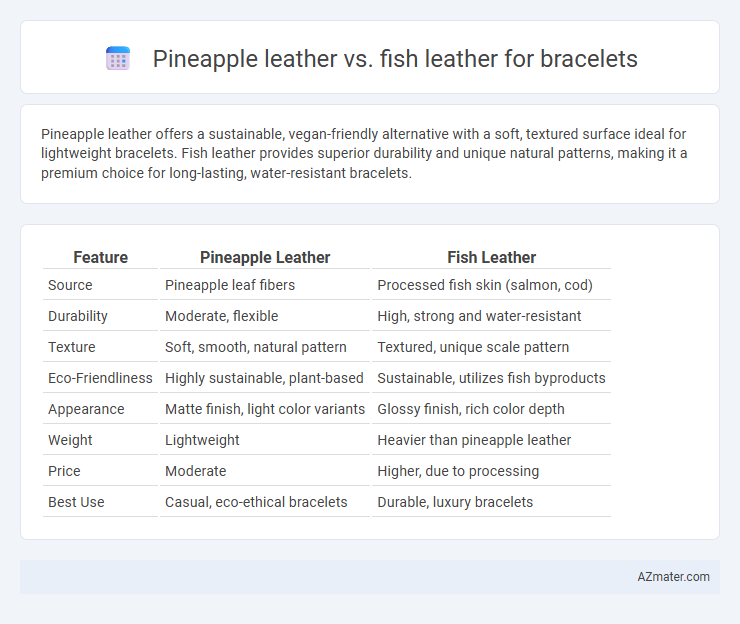Pineapple leather offers a sustainable, vegan-friendly alternative with a soft, textured surface ideal for lightweight bracelets. Fish leather provides superior durability and unique natural patterns, making it a premium choice for long-lasting, water-resistant bracelets.
Table of Comparison
| Feature | Pineapple Leather | Fish Leather |
|---|---|---|
| Source | Pineapple leaf fibers | Processed fish skin (salmon, cod) |
| Durability | Moderate, flexible | High, strong and water-resistant |
| Texture | Soft, smooth, natural pattern | Textured, unique scale pattern |
| Eco-Friendliness | Highly sustainable, plant-based | Sustainable, utilizes fish byproducts |
| Appearance | Matte finish, light color variants | Glossy finish, rich color depth |
| Weight | Lightweight | Heavier than pineapple leather |
| Price | Moderate | Higher, due to processing |
| Best Use | Casual, eco-ethical bracelets | Durable, luxury bracelets |
Introduction to Sustainable Leather Alternatives
Pineapple leather, crafted from agricultural waste like pineapple leaves, offers a biodegradable and eco-friendly alternative to traditional animal leather, reducing environmental impact. Fish leather, made from the skins of fish such as salmon or cod, utilizes byproducts of the fishing industry, promoting waste reduction and contributing to a circular economy. Both materials provide durable and unique textures for bracelets, appealing to environmentally conscious consumers seeking sustainable fashion choices.
Overview of Pineapple Leather
Pineapple leather, known as Pinatex, is an innovative sustainable material made from pineapple leaf fibers, offering durability and eco-friendliness ideal for bracelets. Unlike traditional leather, it is cruelty-free and biodegradable, providing a unique texture that mimics animal leather while reducing environmental impact. Its breathable, lightweight properties make pineapple leather a preferred choice for fashion accessories emphasizing ethical production and modern sustainability.
Overview of Fish Leather
Fish leather, crafted from the durable skins of species like salmon, cod, and perch, offers a unique texture characterized by natural scale patterns and exceptional flexibility. This eco-friendly material boasts high strength and water resistance, making it ideal for durable bracelets that withstand daily wear. Unlike pineapple leather, fish leather provides a distinct aquatic aesthetic and superior longevity, appealing to consumers seeking sustainable yet resilient accessories.
Environmental Impact Comparison
Pineapple leather, made from agricultural waste like pineapple leaves, offers a sustainable alternative with low water usage and minimal chemical processing, significantly reducing environmental pollution compared to traditional leathers. Fish leather, typically a byproduct of fishing industries, utilizes skins that would otherwise be discarded, promoting waste valorization but sometimes involves tanning processes with harmful chemicals. Both materials reduce reliance on conventional animal leather, yet pineapple leather generally boasts a smaller carbon footprint and less water contamination.
Durability and Longevity
Pineapple leather, made from pineapple leaf fibers, offers moderate durability ideal for lightweight bracelets but may show signs of wear faster under daily stress compared to fish leather. Fish leather, especially sourced from species like salmon or perch, is renowned for its exceptional toughness, natural water resistance, and ability to maintain integrity over time, making it highly durable for jewelry applications. The unique fiber structure of fish leather enhances flexibility and longevity, allowing bracelets to withstand regular use without significant degradation.
Aesthetic Qualities and Design Versatility
Pineapple leather offers a smooth, subtle texture with a natural matte finish that enhances minimalist and contemporary bracelet designs. Fish leather features intricate scale patterns and a glossy sheen, providing a distinctive, eye-catching aesthetic ideal for bold, statement accessories. Both materials exhibit excellent flexibility and durability, enabling designers to create a wide range of bracelet styles from sleek bands to intricate woven designs.
Comfort and Wearability Factors
Pineapple leather offers exceptional breathability and lightweight comfort, making it ideal for long-term bracelet wear in warm climates. Fish leather provides superior durability and a unique textured finish, though it may feel stiffer initially and require a break-in period for optimal wearability. Both materials are sustainable choices, but pineapple leather tends to excel in flexibility and softness, enhancing daily comfort.
Ethical Considerations and Sourcing
Pineapple leather, derived from Pinatex made using pineapple leaf fibers, offers an eco-friendly alternative by utilizing agricultural waste and reducing reliance on animal products. Fish leather, created by tanning skins of bycatch or discarded fish, promotes waste valorization but involves complex processing to ensure durability and ethical chemical use. Both materials support sustainable sourcing, with pineapple leather emphasizing plant-based ethics and fish leather highlighting circular economy principles within the fishing industry.
Maintenance and Care Requirements
Pineapple leather bracelets require minimal maintenance, needing only occasional wiping with a damp cloth to remove dirt and prevent drying, while fish leather demands more careful handling due to its delicate, porous texture that benefits from regular conditioning with specialized leather oils to maintain flexibility and prevent cracking. Both materials should be kept away from excessive moisture and direct sunlight to preserve their color and integrity, but fish leather is notably more sensitive to water and prone to damage if exposed frequently. Proper storage in a cool, dry place prolongs the lifespan of these eco-friendly alternatives, with pineapple leather generally offering easier day-to-day upkeep compared to the higher maintenance needs of fish leather.
Which Leather is Better for Bracelets?
Pineapple leather offers lightweight durability and a smooth, vegan-friendly texture, making it ideal for comfortable, eco-conscious bracelets. Fish leather is prized for its natural toughness, distinctive scale patterns, and water resistance, providing a unique and long-lasting option for bracelets. Choosing between the two depends on preferences for sustainability, texture, and durability, with pineapple leather excelling in eco-friendliness and fish leather standing out for strength and aesthetic appeal.

Infographic: Pineapple leather vs Fish leather for Bracelet
 azmater.com
azmater.com